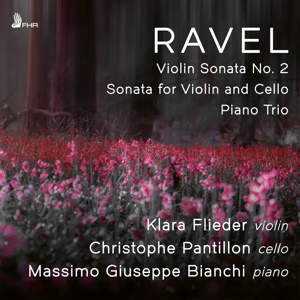
Maurice Ravel (1875-1937)
Violin Sonata No. 2 M. 77 (1923-1927)
Sonata for Violin and Cello MJ. 73 (1920-1922)
Piano Trio M. 67 (1914)
Klara Flieder (violin), Christophe Pantillon (cello), Massimo Giuseppe Bianchi (piano)
rec. 2021, Musikschule Margareten, Vienna, Austrria
First Hand Records FHR158 [66]
Ravel was not a prolific composer; he wrote only a handful of works of chamber music. Apart from the three recorded here, there is the String Quartet, usually and appropriately coupled with the Debussy quartet on which it is modelled, the Introduction and Allegro for flute, clarinet, harp and string quartet, Tzigane and a Berceuse. The three recorded here make a natural grouping through the resources they employ.
The Violin Sonata is the only one Ravel published and is his last chamber work. An early single-movement sonata surfaced many years after the composer’s death, and became numbered No. 1, making this mature work No. 2. He took several years to complete it, and it is in his post-war idiom, characterised by leaner, more angular and more dissonant writing than in his pre-war works. There are three movements. The first movement is a cool, elegant and rather wistful piece. It is followed by a Blues. Ravel enjoyed jazz and was clearly influenced by it here, though his Blues is bitonal. The finale is a chattering number akin to the finale of the G major Piano Concerto.
The Sonata for Violin and Cello is a curious work for a curious combination. This was written in memory of Debussy, with whom Ravel had a difficult relationship, though the affinity of their music is obvious. He saw the work as a turning point, saying ‘The music is stripped to the bone. The allure of harmony is rejected and more and more there is a return of the emphasis on melody.’ The writing is strange, and sounds influenced not only by Stravinsky, who was a friend of Ravel, but possibly also by Schoenberg. There are four movements. In the first, the cello is sometimes written higher than the violin. The second movement is a scherzo, largely played pizzicato, but the effect is not exuberant, as it is in Ravel’s String Quartet, but sinister. The Andante is dissonant and the finale vigorous and featuring the tritone.
The Piano Trio is the last work of the pre-war period and is in the same lush and evocative idiom as other early works. Again there are four movements. The opening one is in an interesting irregular rhythm and incorporates elements from Ravel’s Basque heritage. The second, Pantoum, is a brilliant scherzo. The third is marked Passacaille and builds to a climax over the repeating eight bar theme. The finale is brilliant and triumphant with almost orchestral sonorities. This is a wonderful work and makes a fine climax to the programme here.
The performers here are all experienced chamber music players. Klara Flieder and Christophe Pantillon are a married couple, and, not surprisingly, they work well together. Massimo Giuseppe Bianchi provides excellent support at the piano, witty in the Blues of the Violin Sonata and nimble in the Pantoum of the Piano Trio. He also provides a good sleevenote. The recording is excellent.
There is, of course a great deal of competition in recordings of these works. The same programme, plus the early Violin Sonata, is offered by the Capuçon brothers with the pianist Frank Bailey on Virgin Classics, and was very warmly received though this may now be hard to find (review). A recent version of the Piano Trio by the Linos Piano trio on period instruments has also been praised, though this is coupled with arrangements (review). There are many others of all the works here. However, these are good perfornances and you will not go wrong with them.
Stephen Barber
Buying this recording via a link below generates revenue for MWI, which helps the site remain free.




















